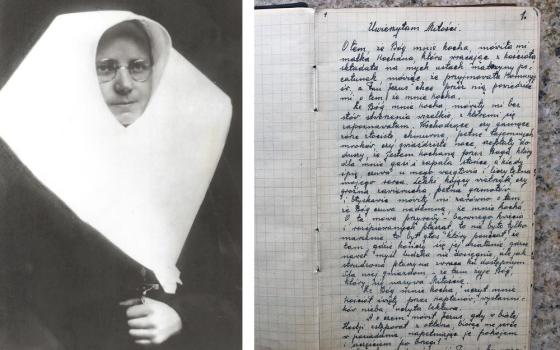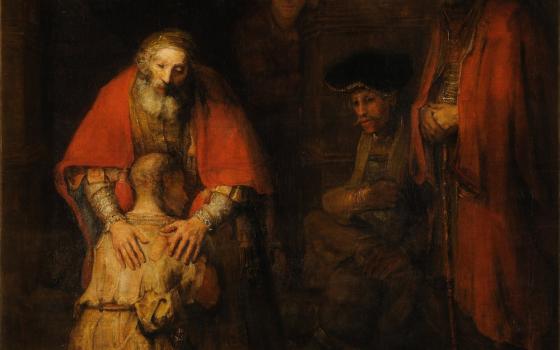
HEARTS ON FIRE: THE STORY OF THE MARYKNOLL SISTERS (CENTENNIAL EDITION)
By Penny Lernoux (with Arthur Jones and Robert Ellsberg)
Published by Orbis Books, $25
Rereading Penny Lernoux’s final book, Hearts on Fire: The Story of the Maryknoll Sisters, is like a re-encounter with an old friend.
For a time in the 1980s, Lernoux had a considerable readership and following in Minnesota, the state where I attended college and began my reporting career. Lernoux was briefly a visiting professor at Macalester College in St. Paul, my alma mater. Anyone who took a course in U.S.-Latin American relations in those days read her work.
Minnesota in the 1980s boasted an unusually large and robust Latin America solidarity community of Roman Catholic, Protestant, Jewish and secular peace activists. To them, Lernoux’s reporting from Latin America in NCR and The Nation was the standard by which other journalism from the region was judged.
But what truly set Lernoux apart was her personal commitment, as a Roman Catholic, to a new vision of what the church could be. When I later wrote a master’s degree paper on Lernoux at New York’s Union Theological Seminary, Kenneth Woodward, then the religion editor at Newsweek, contended Lernoux had overstepped journalistic boundaries and had become an advocate for liberation theology.
 By Newsweek’s definition, I suppose that’s true. But I think that what happened to Lernoux was nuanced. Yes, she broke conventions and, yes, at the end of her life she spoke and wrote frankly about her conversion to the church of the poor she had covered as a journalist. (I can only imagine the heartbreak Lernoux would have experienced had she lived to see Joseph Ratzinger, a dominant and unsympathetic figure in The People of God, become Pope Benedict XVI.)
By Newsweek’s definition, I suppose that’s true. But I think that what happened to Lernoux was nuanced. Yes, she broke conventions and, yes, at the end of her life she spoke and wrote frankly about her conversion to the church of the poor she had covered as a journalist. (I can only imagine the heartbreak Lernoux would have experienced had she lived to see Joseph Ratzinger, a dominant and unsympathetic figure in The People of God, become Pope Benedict XVI.)
Rereading Lernoux’s introduction to Hearts on Fire is to re-encounter afresh some of her best writing. She writes about the call of adventure. And it’s not hard to imagine that even as she writes about the Maryknoll Sisters, in many ways Lernoux is describing her own life as a journalist who began her career in Latin America working for the United States Information Agency and ended it as a hero to Catholic (and non-Catholic) progressives in the United States.
I had forgotten a self-deprecating moment in Hearts on Fire. Following a particularly tough assignment in Bolivia, Lernoux was unwinding in a rocking chair and talking with her host, Maryknoll Sr. Ann Catherine Ryan. Lernoux noticed that in addition to the mud splattered over her pants, her clothes were attracting small black insects.
Ryan told her not to worry -- they were merely fleas. Lernoux recalled that she wailed at the thought, wondering what her husband, Denis Nahum, would say. “We’d just spent two months trying to get rid of our dog’s fleas. The expense -- we sent out all of the carpets -- and now I bring back Bolivian fleas! What am I going to do?”
Lernoux said that Ryan, a “lanky sister in her early 70s who can remember what it was like to wear a nun’s full habit in the awful heat, stopped her rocking chair, drew herself up to her considerable height and gave me an imperious stare. ‘What are you going to do?’ The rocking resumed. ‘Suffer!’ ”
At that, Ryan and Lernoux both burst out laughing. Lernoux recalled: “As if by magic, the fleas ceased to be important, I stopped worrying about the heat, and I discovered I was having a good time. Ann Catherine had said something that was obvious: I was so preoccupied with my middle-class hang-ups that I was missing the beauty and adventure of the place.”
Lernoux treats her subjects with respect and love, and founder Mother Mary Joseph Rogers and a number of missioners (among them Sister Mary Mercy, who served in Korea, Bolivia and later on Manhattan’s Lower East Side) come vividly alive on the page.
Indeed, Hearts on Fire is a riveting read, written in a relaxed, almost conversational style. It is often rollicking fun. Rogers in particular comes off as mighty good company, with a warm and impish sense of humor. One favorite moment: In order to secure the purchase of farmland in Ossining, N.Y., for the sisters’ home and grounds, Fr. James Anthony Walsh, who badly wanted to see a Catholic women’s mission society formed, had to maneuver around the anti-Catholicism of wealthy Protestant property owners in the Hudson Valley. So he enlisted Rogers’ help in a hilarious bit of subterfuge. Wearing a large hat and veil, Rogers presented herself as a wealthy Bostonian to those selling the land. Walsh joined her, attired as a chauffeur. The strategy worked: The sisters got their land.
 Hearts on Fire does not soft-pedal some of the controversies or difficulties the sisters faced. They had to deal with the unfair demands of gender roles. Occasional bumps marked their relationship with the Maryknoll Fathers and Brothers. And the sisters had to overcome European perceptions that American women religious were pampered and ill-suited for mission work.
Hearts on Fire does not soft-pedal some of the controversies or difficulties the sisters faced. They had to deal with the unfair demands of gender roles. Occasional bumps marked their relationship with the Maryknoll Fathers and Brothers. And the sisters had to overcome European perceptions that American women religious were pampered and ill-suited for mission work.
Of course, they had to make major adjustments after the Second Vatican Council (1962-65), when their numbers dwindled. Worse still, they had a serious public relations problem. In 1967, several Maryknoll Sisters in Guatemala, angry over injustices, joined with a small group of Maryknoll priests and began making plans to join a guerrilla uprising. (Their plans unraveled.) That is an image that still clings to the sisters in some conservative quarters -- and continues to rankle many Maryknollers and their supporters to this day.
One of the book’s best and most representative chapters comes toward the end. It recounts how Sr. Mary Grenough, who arrived in the Philippines in 1964, ended up championing the cause of striking sugar workers on the island of Negros and refused to back down despite heavy pressure from the targeted sugar company. By the end of the 1980s, Lernoux recounts, “Grenough was mainstream in the community, with a significant number of Sisters in similar direct ministries with the poor. The Sisters had grown with the times.”
So they had. Lernoux notes that, in a sense, the story of the Maryknoll Sisters reflects the history of the “ ‘American Century’ of economic, political and religious expansion, and the traits that distinguish them -- individuality, courage, generosity -- are American characteristics. But these Maryknollers are different as well, because they stand outside the mainstream: Like others who seek a different dimension of life, they beckon us to that part of the American dream that does not depend on material success but is inspired by religious ideals.”
Much the same can be said about Penny Lernoux. She was a distinctly American figure who wrote about the unsavory machinations of U.S. foreign policy in Latin America during the height of the American century. In doing so, Lernoux found herself “adopted” by the Maryknoll Sisters -- an unusual place for a journalist to be, for sure, but one that made perfect sense given the trajectory of her unique life and career.
In a moving testament to that “adoption,” Penny Lernoux is buried at the Maryknoll Sisters’ cemetery in Ossining. But Hearts on Fire is probably the truest testimony to the commitment she shared with the sisters -- a belief that “the essence of a dedication to God [is] love of others.”
[Chris Herlinger writes for the humanitarian agency Church World Service. He is a New York-based freelance journalist, and was recently on assignment in Kenya and Ethiopia for NCR. His book Rubble Nation: Haiti’s Pain, Haiti’s Promise was just published by Seabury Books.]
The works of Penny Lernoux
|


